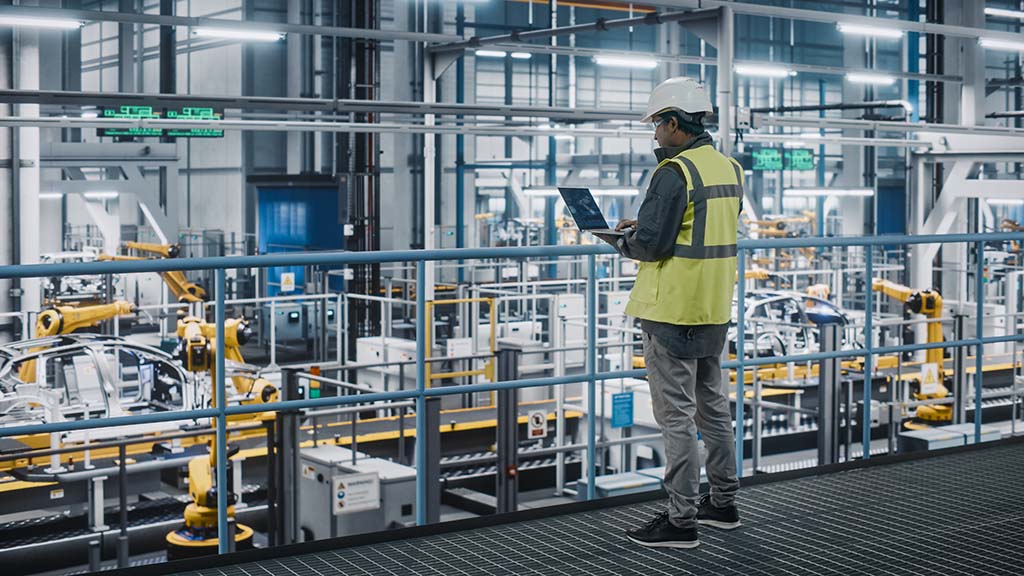Summary:
- Industrial automation and IoT work together to enhance visibility, responsiveness, and efficiency in modern operations.
- Real-time monitoring gives teams immediate insight into equipment performance and system status.
- Predictive maintenance helps reduce unplanned downtime by identifying issues before they lead to failure.
- Smart systems and automated workflows enable faster, data-driven actions without manual intervention.
- IoT applications range from asset tracking and safety monitoring to remote control and system integration.
Industrial automation isn’t what it used to be. What once relied on rigid, pre-programmed systems now thrives on real-time data, connected devices, and smarter decision-making. At the center of this shift is the growing relationship between industrial automation and IoT.
By combining traditional automation with the Internet of Things (IoT), industrial operations are getting a serious upgrade. Machines can now communicate, systems can adjust on the fly, and teams have access to live insights that help them stay ahead of problems instead of just reacting to them.
In this article, we’ll explore how industrial automation and IoT are working together to create more efficient, flexible, and intelligent systems, and why this matters for industries looking to future-proof their operations.
The Convergence of IoT and Industrial Automation
The gap between operational technology (OT) and information technology (IT) is closing, and that’s where the real potential of IoT begins to show. Traditionally, industrial automation systems were built to execute specific tasks, like controlling machinery or managing workflow sequences. They worked well but operated in isolation, with limited visibility into the broader operation.
Today, the combination of IoT and industrial automation is changing that landscape. By integrating IoT sensors into equipment and systems, organizations can collect real-time data on performance, conditions, and usage. That data can then be transmitted to platforms where it’s analyzed and used to drive smarter decisions.
This is what makes industrial automation in IoT so impactful. It connects machines, people, and systems into a single network that can respond quickly, learn over time, and adapt to changing conditions.
For businesses using Open Automation Software, this might look like integrating data from PLCs into cloud dashboards, automating alerts when a metric goes out of range, or syncing plant-floor insights with enterprise tools.
As more industries adopt this approach, automation is no longer just about efficiency. It’s about creating intelligent systems that learn, communicate, and evolve for safer and more flexible operations.
Real-Time Monitoring and Decision-Making
A major advantage of combining IoT and industrial automation is gaining real-time visibility into operations. Instead of relying on manual checks or delayed system logs, IoT sensors now provide live data that’s accessible anytime.
This immediate insight helps teams detect issues as they happen, not after the fact. With continuous data flowing from machines and control systems, operators can monitor performance, environmental conditions, and equipment status across locations.
Open Automation Software supports this by connecting industrial devices to visualization tools. Users can build real-time dashboards, trigger alerts, and create automated workflows without the delays of traditional polling methods.
By turning live data into immediate action, industrial automation and IoT help businesses reduce downtime, minimize waste, and improve daily operations.
Predictive Maintenance and Downtime Reduction
In traditional industrial environments, maintenance was often reactive. A machine would fail, production would halt, and the scramble to fix the issue would begin. With the integration of IoT and industrial automation, that reactive cycle is becoming a thing of the past.
By using IoT sensors to continuously track the condition of equipment, businesses can shift to a predictive model. Instead of waiting for a problem, systems detect early warning signs like abnormal vibrations, temperature spikes, or declining performance, and alert teams before failure occurs.
This approach is one of the many advantages of IoT-based industrial automation. It allows operators to catch potential issues early, schedule maintenance only when necessary, and avoid the costs associated with unnecessary downtime or premature part replacements.
Smart Systems and Automated Workflows
Smart systems do more than track performance. They use real-time data to trigger responses, adjust operations, and keep things running smoothly without waiting for human input. This leads to quicker reactions, fewer manual steps, and more consistent outcomes.
For example, if a sensor detects a drop in pressure, the system can slow down a process, notify the right people, and log the event all at once.

Creating Workflows That Run on Their Own
With platforms like Open Automation Software, teams can set up workflows that respond automatically to specific conditions. Data from sensors, PLCs, databases, and cloud applications can all work together within one system. Rules can be customized so that when something happens, the right steps follow immediately.
This kind of automation helps reduce delays and takes pressure off busy teams.
Faster Responses With Edge Computing
When timing is critical, edge computing makes a big difference. By processing data at the source, like on a local device or machine, the system can respond quickly without needing to wait for instructions from the cloud. This is especially useful for safety-related actions or rapid process adjustments.
These smart workflows are also easy to scale. You can add more devices or expand to new sites without needing to rebuild your entire setup. That flexibility helps teams stay efficient and ready to grow.
Main Applications of IoT in Industrial Automation
IoT supports a wide range of use cases in industrial environments, helping teams improve performance, safety, and efficiency across systems.
Environmental and Safety Monitoring
Data from connected sensors ensures safe working conditions by tracking temperature, humidity, vibration, and other environmental factors.
Remote Access and Control
Operators can monitor and adjust systems from anywhere, which is especially useful for remote sites or large-scale operations.
H3 System Integration
IoT enables seamless data sharing between devices, cloud platforms, and enterprise tools. Solutions like Open Automation Software connect OT and IT systems for streamlined workflows.
Taking the Next Step with IoT-Driven Automation
Industrial operations are no longer confined to fixed processes and isolated systems. As IoT continues to evolve, it opens the door to more responsive, data-driven, and intelligent automation strategies. The ability to adapt quickly, automate with precision, and make informed decisions in real time is no longer a future goal—it’s happening now.
If you’re exploring how to bring more flexibility, insight, and control to your industrial systems, Open Automation Software can help. Our platform is built to connect your data, streamline your workflows, and support smarter operations from edge to cloud.
Ready to see it in action? Schedule your free demo with Open Automation Software and discover what’s possible with IoT-powered industrial automation.
